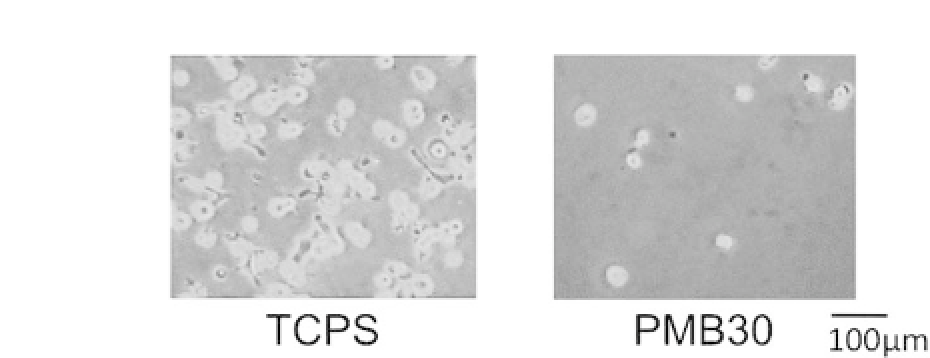Biomedical Engineering Reference
In-Depth Information
Figure 19.5.
Phase-contrast micrographs of differentiated HL-60 cells
adhered on polymer surfaces.
that on conventional biomedical polymers such as poly(ethylene
telephatalate) (PET), segmented polyurethane, and Tecoflex
R
60,
even after coating with hydrophilic poly(2-hydroxyethyl methacry-
late) (PHEMA).
However,therewasnosignificantdifferencebetweentheamount
of protein adsorbed on tissue culture polystyrene (TCPS) and that
on PMB5 (with 5 mol% MPC units) and PMB10 (with 10 mol%
MPC units). On the basis of the increment of the MPC unit con-
tent to PMB30 (with 30 mol% MPC units), the amount of adsorbed
protein was effectively decreased. This result suggests that the
MPC units in the PMB play an important role in reducing protein
adsorption.
11
,
13
,
15
,
17
These phenomena may be explained with the
water structure on MPC polymer surfaces. That is, on MPC poly-
mer surfaces, the free water fraction is larger than that on other
hydrophilic polymers. This hypothesis remains, and much experi-
mental data can support this hypothesis. When the free water frac-
tion in the polymer is increased, the amount of adsorbed bovine
serum albumin or bovineplasma fibrinogenis decreased. The effect
of water-soluble polymers on the water structure has also been dis-
cussedbyKitano
et al
.
28
Theyexplainedthatthewaterstructureina
poly(MPC)aqueoussolutionissimilartothatofnaturalwater.Thus,
the hydrophobic interaction between protein and polymer surfaces
istoo weakto adsorb proteins.
Figure 19.5 shows phase contract micrographs of differentiated
HL-60 cells adhered on TCPS and PMB.








Search WWH ::

Custom Search